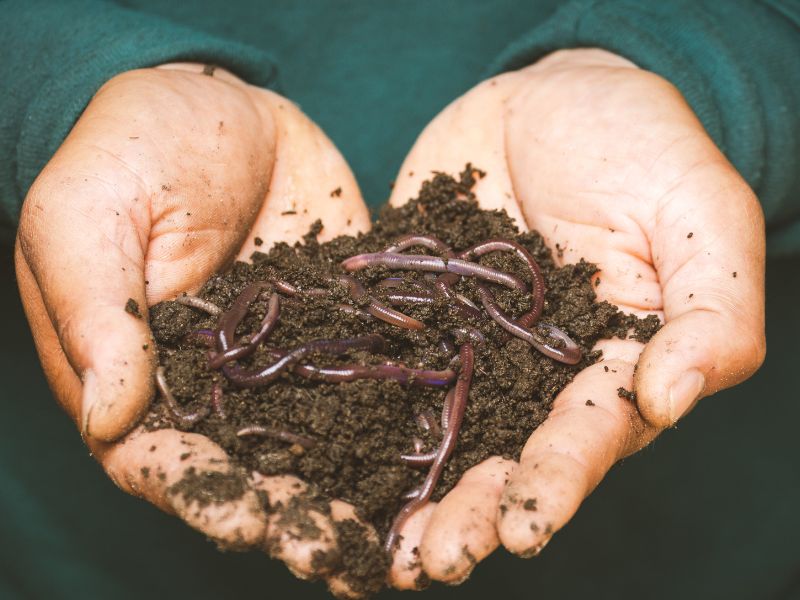Understanding the Conveniences of Red Wiggler Composting: Just How This Efficient Technique Transforms Organic Waste Into Nutrient-Rich Dirt Amendments
Red Wiggler composting, employing the varieties Eisenia fetida, offers an engaging method to natural waste monitoring, converting kitchen area scraps and backyard debris right into beneficial soil changes. This method not just improves dirt fertility however additionally addresses pressing ecological problems, consisting of garbage dump waste decrease and greenhouse gas discharges.
What Are Red Wigglers?
Red wigglers, medically called Eisenia fetida, are a varieties of earthworm that play a pivotal function in vermicomposting systems. These worms are identified by their reddish-brown shade, fractional bodies, and an unique capacity to prosper in organic-rich settings, making them ideal for composting applications - Red Wiggler Composting. Unlike their garden-dwelling equivalents, red wigglers prefer to populate the top layers of soil, where decomposing issue is plentiful
Usually determining in between 3 to 4 inches in length, red wigglers have a high reproductive rate, enabling them to multiply swiftly under optimal conditions. They possess an one-of-a-kind digestive system that permits them to process organic waste effectively, converting it into nutrient-rich castings, which are extremely valuable for plant growth.
Their resistance to varying dampness degrees and temperature ranges further enhances their utility in vermicomposting setups, making them a favored selection amongst composting fanatics. Furthermore, red wigglers are aerobic microorganisms, which demands a well-aerated composting environment, guaranteeing reliable disintegration. Understanding the biological traits and actions of red wigglers is important for maximizing their use in lasting waste administration practices.

Benefits of Vermicomposting
Utilizing the power of vermicomposting deals a wide range of farming and ecological benefits. Firstly, it dramatically minimizes organic waste in landfills, thus lessening methane exhausts, a potent greenhouse gas. By drawing away food scraps and backyard waste to vermicomposting, we support a more lasting waste monitoring system.
Additionally, vermicomposting enhances soil health. The spreadings created by red wigglers are rich in crucial nutrients, microorganisms, and enzymes, boosting soil framework and fertility. This nutrient-rich amendment advertises robust plant development and increases water retention, reducing the requirement for chemical plant foods.
In addition, vermicomposting fosters biodiversity in the soil ecological community. The introduction of valuable microbes from worm castings aids in condition suppression and nutrient biking, developing a much healthier environment for plants.
Economically, vermicomposting decreases the expenses connected with chemical inputs and waste disposal. Farmers and garden enthusiasts can cultivate high-quality fruit and vegetables at reduced costs, adding to food security and sustainability.
Just How to Beginning Composting
Starting a composting venture can be a gratifying and simple procedure. This will certainly assist maintain a well balanced temperature, important for the composting process.
Gather organic materials such as kitchen area scraps, yard waste, and shredded paper. Go for a balanced mix of 'eco-friendly' materials, high in nitrogen (e.g., fruit scraps, coffee premises), and 'brown' products, abundant in carbon (e.g., dried out fallen leaves, cardboard) A ratio of approximately 2:1 eco-friendly to brown products is ideal.
Begin layering your materials, ensuring appropriate air circulation by turning the heap consistently. This advertises cardiovascular disintegration, decreasing smells and speeding up the procedure. Screen dampness levels; the garden compost should feel like a moist sponge however not excessively damp.
Nutrient Account of Vermicompost
Composting, especially with red wigglers, yields a nutrient-rich item called vermicompost. This organic modification is identified by its high concentration of important nutrients, making it a very useful resource for horticulture and farming. Vermicompost generally consists of raised degrees of macronutrients such as nitrogen, phosphorus, and potassium, which are important for plant growth. hop over to these guys Additionally, it provides trace elements like iron, magnesium, and calcium, cultivating durable plant growth and enhancing soil health and wellness.
The microbial activity present in vermicompost even more enhances its account, introducing beneficial bacteria and fungi that promote vitamins and mineral accessibility and uptake in plants. This organic element aids in suppressing plant illness and improving dirt framework, resulting in boosted water retention and aeration.

Environmental Effect of Composting
The environmental influence of composting, especially with making use of red wigglers, is profound and multifaceted. This method significantly reduces the quantity of organic waste sent out to land fills, which subsequently lessens greenhouse gas exhausts, specifically methane-- a powerful factor to environment modification. By drawing away organic products from land fills, red wiggler composting not just helps alleviate ecological destruction but likewise check that promotes sustainable waste administration techniques.

Moreover, composting adds to carbon sequestration, as the procedure captures carbon dioxide from the environment and stores it in the soil. This natural process aids in combating climate change while enriching the soil - Red Wiggler Composting. Generally, red wiggler composting offers a feasible, eco-friendly remedy for waste management and ecological sustainability, advertising healthier ecosystems and an extra sustainable future
Final Thought
Finally, Red Wiggler composting functions as an efficient approach for converting natural waste into beneficial soil changes. The procedure not just improves dirt fertility and structure however also mitigates ecological issues related to garbage disposal. By utilizing Eisenia fetida, this kind of vermicomposting adds to boosted biodiversity and sustains lasting farming methods. Ultimately, Red Wiggler composting plays an important role in promoting healthier environments and attending to the challenges of environment modification.
Red Wiggler composting, using the types Eisenia fetida, offers a compelling approach to organic waste administration, transforming kitchen scraps and backyard particles into important dirt modifications. Unlike their garden-dwelling counterparts, red wigglers favor to occupy the top layers of dirt, where decomposing matter is bountiful.
The spreadings created by red wigglers are abundant in necessary nutrients, germs, and enzymes, enhancing soil structure and fertility. The nutrient-rich by-products of red wiggler task enhance dirt structure, increase water retention, and promote biodiversity within the soil ecological community.In final thought, Red Wiggler composting serves as an effective method for transforming natural waste right into beneficial dirt changes.